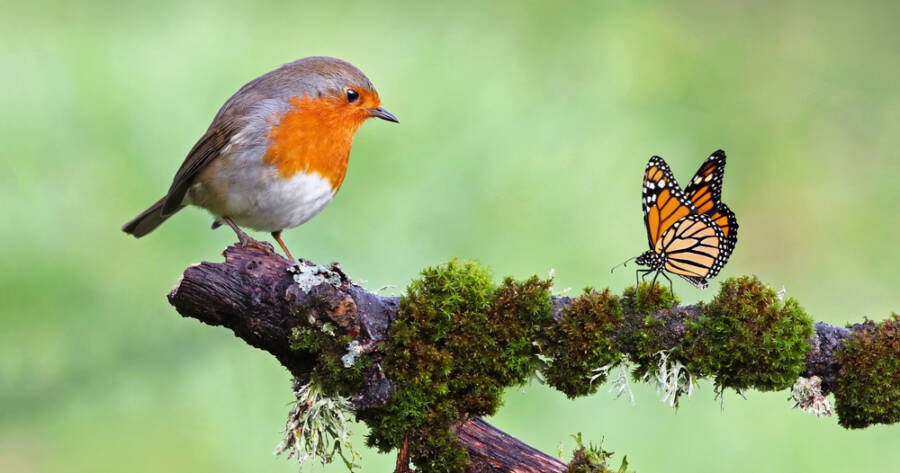A thriving garden filled with birds and butterflies brings color, movement, and life to any outdoor space. These winged visitors play a crucial role in pollination and pest control, making them valuable allies in maintaining a healthy ecosystem. By creating a welcoming habitat with native plants, fresh water, and safe shelter, you can turn your garden into a sanctuary for these beautiful creatures. A few simple changes will invite nature’s most captivating guests to your backyard.
Plant Native Flowers for Nectar and Seeds
Native plants are the foundation of a bird- and butterfly-friendly garden. They provide nectar, pollen, and seeds that local species rely on for survival. Bright, nectar-rich flowers like coneflowers, milkweed, and bee balm attract butterflies, while seed-producing plants such as sunflowers and black-eyed Susans entice birds.
Choosing a variety of flowers that bloom in different seasons ensures a continuous food source. Clustering plants together in patches mimics natural habitats, making them more inviting. Avoid hybrid or double-petal varieties, as these often lack nectar.
Additionally, let some flowers go to seed instead of trimming them back—this provides birds with a vital food source in fall and winter. A garden filled with native plants becomes a natural oasis for winged visitors.
Provide a Fresh Water Source
Water is essential for both birds and butterflies, but it’s often overlooked in garden design. Birds need it for drinking and bathing, while butterflies gather moisture and minerals from shallow puddles. A simple birdbath, shallow dish, or small water fountain can attract a variety of species.
Place water sources in a shaded, quiet spot to keep them cool and safe. Adding stones or pebbles to shallow water allows butterflies to perch while they drink. To prevent mosquito breeding, change the water regularly and clean birdbaths to avoid algae buildup. If space allows, a small pond or drip fountain can create an even more inviting environment. A reliable water source will quickly turn your garden into a popular gathering spot.
Create Shelter and Nesting Spaces
Birds and butterflies need safe spaces to rest, nest, and take cover from predators. Dense shrubs, hedges, and trees provide natural shelter where birds can roost and build nests. Leaving some brush piles or tall grasses undisturbed gives ground-nesting birds and caterpillars a place to hide.
Consider installing birdhouses designed for local species, positioning them in quiet, elevated areas. For butterflies, host plants like milkweed and parsley provide a habitat for caterpillars to grow.
Flat stones placed in sunny areas offer butterflies a warm spot to bask and regulate their temperature. Reducing the use of chemical pesticides ensures these safe spaces remain free from harmful toxins. A well-structured garden provides a protective haven for all kinds of wildlife.
Offer Natural Food Sources Year-Round
Providing a steady food supply throughout the year encourages birds and butterflies to stay in your garden. Nectar-rich flowers support butterflies in spring and summer, while berry-producing shrubs like holly and elderberry sustain birds in colder months. Leaving seed heads on plants instead of trimming them provides natural foraging opportunities.
Supplemental feeders stocked with black oil sunflower seeds, suet, and nyjer seed attract finches, cardinals, and woodpeckers. For butterflies, rotting fruit left in a dish mimics the sugars they find in nature. Avoid using insecticides and herbicides, as these can eliminate essential food sources like caterpillars and insects. A diverse selection of natural food ensures that birds and butterflies will find everything they need to thrive year-round.
Use Organic Gardening Practices
A pesticide-free garden is essential for attracting birds and butterflies. Chemical insecticides kill off the very insects that birds and caterpillars rely on for food, disrupting the natural ecosystem. Instead, use organic methods like companion planting and introducing beneficial insects such as ladybugs and praying mantises to control pests naturally. Composting enriches the soil without synthetic fertilizers, leading to healthier plants and more nectar production.
Mulching with leaves and bark provides a habitat for insects, which in turn feeds birds. Handpicking harmful pests like aphids and using neem oil or soap sprays sparingly can maintain balance without harming wildlife. An organic approach keeps your garden healthy while ensuring that visiting birds and butterflies have a safe, toxin-free environment.
Incorporate Climbing Vines and Layered Landscaping
A well-designed garden with multiple layers—ground cover, shrubs, trees, and vines—creates a dynamic habitat that supports more wildlife. Climbing plants like honeysuckle and trumpet vine provide nectar for butterflies while offering shelter for small birds. Taller trees and shrubs act as perches and nesting sites, while flowering ground covers like creeping thyme provide additional nectar sources.
Layered landscaping mimics natural habitats, making the space more inviting for different species. If space is limited, trellises or vertical gardens can add height and maximize available area. Mixing a variety of plants encourages biodiversity, giving birds and butterflies a safe, abundant place to explore. The more natural and varied the garden, the more likely it is to attract these beautiful visitors.
Transform Your Garden into a Wildlife Haven
Creating a welcoming space for birds and butterflies is easier than it seems. By planting native flowers, providing fresh water, offering shelter, and avoiding harmful chemicals, you can turn your garden into a thriving ecosystem.
Even small changes, like adding a birdbath or letting wildflowers grow, make a big impact. The more inviting your space becomes, the more nature will reward you with its beauty. With a little care, your garden can become a vibrant sanctuary filled with color, movement, and life.

